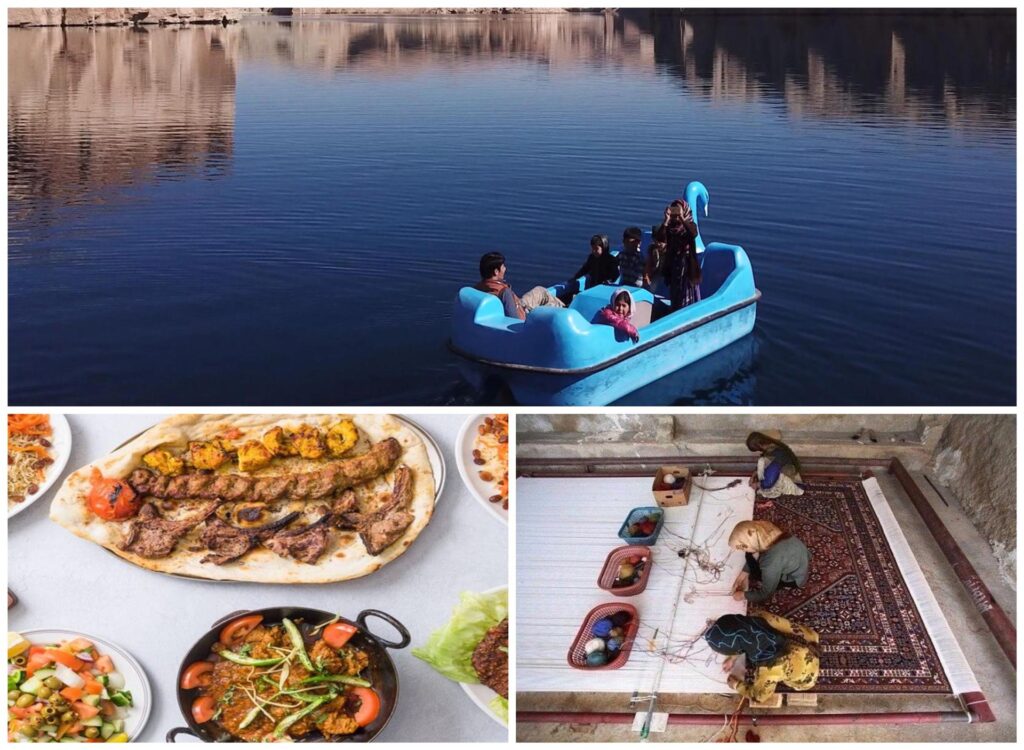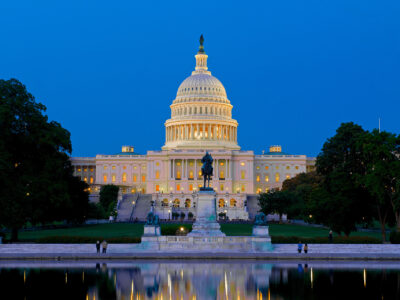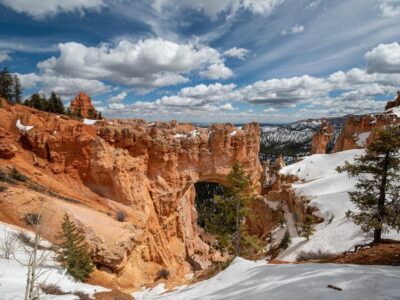
There was a time when Hollywood and Bollywood films were easily shot with the rugged background of the Bamiyans or at the Registan Desert
Most Indians would associate Afghanistan with the scenes from Amitabh Bachchan’s Khuda Gawah or Firoz Khan’s Dharmatma which were actually shot in Afghanistan before the country got embroiled in decades of violence and insurgency. Tourism in Afghanistan was at its glorious best in the 1970s. There was a time when Hollywood and Bollywood films were easily shot with the rugged background of the Bamiyans or at the Registan Desert. But then the war broke out and the horrors of terrorism exploded. Today, despite decades of war, due to its deep cultural heritage, the country remains as fascinating as it is projected in modern Bollywood films like Kabul Express, Tiger Zinda Hai or Agent Vinod!
Due to its location, Afghanistan was of great strategic importance for invading armies, from Genghis Khan to Alexander the Great, all of which have left behind astonishing cultural trails that are visible in its over 6,000-year-old history and heritage sites and attractions. However, in the last 40 years, the country has been in chaos due to major wars, from the Soviet invasion of 1979 to their withdrawal in 1989 and to the rise of the Taliban in 1996 and the ongoing battle between the Taliban and the US-led NATO armies. However, the country is currently going through a nation-wide rebuilding process. Due to the presence of the international community and the ongoing redevelopment projects, Afghanistan, more specifically capital city Kabul, is being given a touch of modernity over its ancient altar.
While visiting the cultural spots in Afghanistan, tourists generally base in a secured hotel in Kabul and make a round of trips to the must-see spots. The main criteria to choose a hotel in Afghanistan are its security arrangements and the area it is located in. It is important to note, safe hotels are expensive, and anyway, Kabul is not a cheap place to stay, primarily because of its expenses of running generators and providing standard security. Many tourists prefer Afghan-style guest houses over hotels in Wazir Akbar Khan and Shar-i-Naw areas, but for safety reasons, it is better to stay protected in a secure hotel. Many big hotels like the popular Moon Hotel Kabul in Malalai Hospital Square or Kabul Serena Hotel in Froshgah Street are sometimes attacked by insurgent groups, as businessmen and organisation workers are mostly the targets. Hence, security arrangements and previous attack track record are important for consideration before choosing a place to stay.
In the Sher-e Naw Park area, there are a few supermarkets like Chelsea Supermarket, or Kabul City Center shopping mall where tourists do their bit of shopping. Majid Mall situated in Supreme Tower is the largest shopping mall in Afghanistan. Roshan Plaza has some decent garments shops, while Chicken Street is famous for its touristic affairs like carpets, carvings, knives and pirated DVDs. Going to any open market without a known Afghan guide is strictly discouraged.
Afghan food is mouth-watering, so is the street food of Kabul. The once-flourishing restaurant-scene in Kabul has suffered in recent years. Restaurants can crudely be split into ‘places for locals’ and ‘places for foreigners’ with the latter having tighter security, expensive dishes but not necessarily serving great food. Restaurants that are UN approved are particularly expensive. If you are looking for a place with a good mix of Afghans and international diners, then Lebanese, Turkish and Iranian restaurants are the ones to head towards.
The vast number of foreigners in Kabul has led to the city being perhaps the best place to eat in the region, starting from budget to mid-range to luxurious fine dining. Anaar Restaurant & Bar, located between Wazir Akbar Khan circle and Heetal Plaza Hotel has UN security clearance and serves good Indian and Asian cuisine served by English speaking staff. Delhi Darbar situated at Cinema Zainab Road in the Sher-e-Naw area also serves good Indian food including a USD 6 thali. For fine dining, tourists go to Raven Restaurant, Café Zarnegar or Silk Route Restaurant in the Kabul Serena Hotel or Gandamack Lodge at Sherpur Square, next to the UNHCR, one of Kabul’s classiest establishments serving a varied menu in an international atmosphere.
A tourist is called a Musafir in Afghanistan and visitors are considered guests, similar to the Indian concept of Athithi Devo Bhava. Since, hospitality is an integral part of Afghan culture, with the best possible food served to guests, followed by a cup of hot tea. Tea is drunk multiple times every day, is offered to all guests and most families have their own unique recipe.
Afghan cuisine is extremely rich in texture, smell and ingredients and quite famous among the Indians. Major meals are traditionally eaten communally, sitting on large colourful cushions called Toshak placed around a low table called a Sandali. From various Kebabs, Koftas, Qormas, Shorbas and Palaws to different breads mainly prepared in wood-fired clay ovens and seasonal fruits, a variety of special dishes are prepared throughout the year. During any religious celebrations or festivals, engagements or weddings, there is always an excuse to be a gourmand. Afghan cuisine is largely based on wheat, maize, barley and rice. Accompanying these staples are native fruits and vegetables and dairy products such as milk, yogurt and whey. The nation’s culinary specialities reflect its ethnic and geographic diversity. Afghanistan is known for its high-quality pomegranates, grapes, and sweet, rugby-football shaped melons. The national dish of Afghanistan is Kabuli Palaw, a rich dish of rice with meats, vegetables and ample dry fruits.
Afghanistan’s most famous handicrafts are Baluchi carpets and rugs. Though not as finely woven as carpets from the cities of neighbouring Iran, many of them are quite beautiful and priced reasonably if one is able to bargain well. Another common product and popular souvenir is the Afghan sheepskin coat which has wool on the inside for warmth and leather on the outside to block wind, rain and snow. There are also various bits of metalwork – heavily decorated pots, vases and platters, and some quite nice knives.
Afghan literature and music are also quite celebrated and loaded with influential elements from various provinces. Afghan folk music from the southern Pashtun regions that come in the poetic form of a Landay, composed of nine and thirteen-syllables, contrast with the Dari four-line Chahar Baiti form traditionally found in the West. Fused together with western-influences with the foundation of Radio Kabul in 1941, a nation-wide Afghan style of music began to form. It was this era that produced internationally famous Afghan artists such as Ahmad Zahir and later Farhad Darya.
But over and above, Bollywood films and their music rule Afghanistan. For decades Afghans have been smitten with Indian superstars, their films and their blockbuster movies. It is part of Afghan culture to play Bollywood music every now and then, here and there and many Afghans comprehend Hindi very well. Everywhere in the big cities or even in small towns, one can find shops where pirated Hindi films and music CDs are not only sold but also showed for small groups of audiences on pay per view system.
However, films that feature some elements of Afghan connections, mainly historical connections, do not go down well as the Afghan government thinks the projection of their country or their people and historical figures have been mostly negative. While any Amitabh Bachchan, Shah Rukh Khan, Salman Khan or Aamir Khan movie would do pretty well in Afghanistan, but recently films like Padmavat, Panipat, Kesari have received criticism due to their negative projections of Mughal emperors who are held in high esteem in the Afghan culture and people’s mind.
Though from a pure tourism point of view, there are more than 2,000-year-old famous Buddha statues (now ruined), the tomb of Hazrat-e Ali (the son-in-law of Prophet Mohammed and the fourth Caliph of Islam) in Mazar-e Sharif, the resting place of Mughal Emperor Babur in Kabul, and the breathtaking lakes of Band-e Amir in the Bamyan province among others, but the essence of Afghanistan lies in its people, in its culture, and in its legends!
Star Cultural Attractions of Afghanistan
Buddhas of Bamiyan (The Ruins)
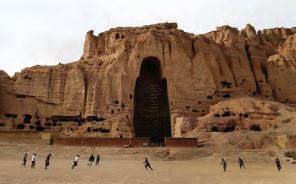
Buddhas of Bamiyan (The Ruins)
The Buddhas of Bamiyan were two 6th century monumental statues of Gautama Buddha carved into the side of a cliff in the Bamiyan valley of central Afghanistan, 130 km northwest of Kabul and surrounded by numerous caves and surfaces decorated with paintings. Carbon dating of the structural components of the Buddhas had determined that the smaller (38 m) Eastern Buddha was built around 570 AD, and the larger (55 m) Western Buddha was built around 618 AD, showcasing a later evolution of Gandhara art. It was considered as an artistic synthesis of Buddhist art and Gupta art from India, with influences from the Sasanian Empire and the Byzantine Empire, as well as the country of Tokharistan. The statues were blown up and destroyed in March 2001 by the Taliban, generating worldwide horror and protest. Though the figures have been destroyed, their outlines and some features are still recognisable within the recesses making it possible for visitors to explore the monks’ caves and passages that connect them. A major rebuilding commitment has been pledged by the international community.
Bagh-e Babur (Kabul)
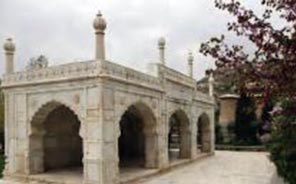
Bagh-e Babur (Kabul)
Bagh-e Babur or the garden of Babur in Kabul is the resting place of the first Mughal Emperor Babur. Thought to have been developed around 1528 AD when Babur gave orders for the construction of an avenue garden in Kabul, describing in some detail in his memoirs, the Baburnama, Bagh-e Babur is located on the slopes of Kuh-e Sher Darwaza, southwest of the old city of Kabul. From the top terrace, the visitors get a magnificent vista over the garden and its perimeter wall, across the Kabul River towards the snow-covered mountains. Though he died in Agra in 1530, Babur missed his home country and thus wished to be buried in Kabul. His body was transferred to Bagh-e Babur around 1544. As the tomb garden of the founder of the Mughal dynasty, Bagh-e Babur became a place of veneration, a cultural symbol and hence gained importance among Babur’s gardens. For nearly 150 years, his heirs, especially Jahangir and Shah Jahan paid their respects to his burial place and sponsored ambitious building programmes to preserve and beautify the garden according to contemporary taste. Evidence of different phases of renovation by later rulers was brought to light in 13 seasons of excavation carried out by the archaeologists supplemented by information from historical documents, book illustrations, drawings and photographs.
Ghazni citadel

Ghazni citadel
The citadel of Ghazni is a large 45-metre-high medieval fortress located in Ghazni city, east-central Afghanistan, built in the 13th century surrounding the Ghazni town to form a walled city. Many of the towers and walls of the fortress are crumbling thanks to decades of war, continued political instability and lack of funds hampering the restoration efforts. In June 2019 one of the citadel’s 32 original towers collapsed and was caught on video and posted to social media sparking international calls to do more to preserve this Afghan cultural heritage.
Loy Kandahar (Kandahar)
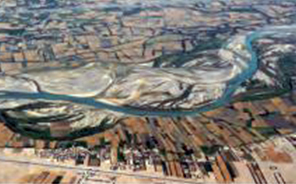
Loy Kandahar (Kandahar)
Kandahar is Afghanistan’s second-largest city after Kabul, and also the centre of the larger cultural region called Loy Kandahar. Kandahar is one of the most culturally significant cities of the Pashtuns and has been their traditional seat of power for more than 300 years. It is a major trading centre for sheep, wool, cotton, silk, felt, food grains, fresh and dried fruit, and tobacco. The region produces fine fruits, especially pomegranates and grapes, and the city has plants for canning, drying, and packing fruit, and is a major source of marijuana and hashish. The region around Kandahar is one of the oldest known human settlements. Many empires have long fought over the city due to its strategic location along the trade routes of southern, central and western Asia.








